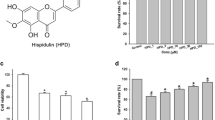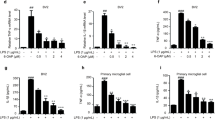Abstract
Microglia activation plays an important role in the pathogenesis of various neurodegenerative diseases by producing neurotoxic factors, such as proinflammatory cytokines and nitric oxide (NO); therefore, suppression of microglia activation is a potential therapeutic approach against these diseases. Previous study showed that alismol, a sesquiterpenoid isolated from the roots of Vladimiria souliei inhibits interferon-γ-induced NO production in murine macrophage RAW264.7 cells. In the present study, we found that alismol reduced NO and prostaglandin E2 (PGE2) levels and suppressed the expression of inducible nitric oxide synthase (iNOS) and cyclooxygenase-2 (COX-2) in lipopolysaccharide (LPS)-stimulated primary and cultured microglia. Alismol also inhibited the mRNA and protein expression of proinflammatory cytokines including interleukin (IL)-1β, IL-6, and tumor necrosis factor (TNF)-α. Further mechanistic studies revealed that alismol inhibited LPS-induced nuclear factor-κB (NF-κB) activation but not mitogen-activated protein kinase (MAPK) pathway. Finally, we demonstrated the neuroprotective effects of alismol in microglia-neuron coculture systems. Collectively, these results suggest that the inhibition of microglia activation by alismol may provide potential therapeutic strategy for various neuroinflammatory diseases.





Similar content being viewed by others
References
Chao CC, Hu S, Molitor TW, Shaskan EG, Peterson PK (1992) Activated microglia mediate neuronal cell injury via a nitric oxide mechanism. J Immunol 149:2736–2741
Chen H, Jacobs E, Schwarzschild MA et al (2005) Nonsteroidal anti-inflammatory drug use and the risk for Parkinson’s disease. Ann Neurol 58:963–967
Choi Y, Lee MK, Lim SY, Sung SH, Kim YC (2009) Inhibition of inducible NO synthase, cyclooxygenase-2 and interleukin-1β by torilin is medated by mitogen-activated protein kinases in microglia BV2 cells. Br J Pharmacol 156:933–940
Cui CA, Jin DQ, Hwang YK et al (2008) Macelignan attenuates LPS-induced inflammation and reduces LPS-induced spatial learning impairments in rats. Neurosci Lett 448:110–114
Dickson DW, Lee SC, Mattiace LA, Yen SH, Brosnan C (1993) Microglia and cytokines in neurological disease, with special reference to AIDS and Alzheimer’s disease. Glia 7:75–83
Du Yan S, Zhu H, Fu J et al (1997) Amyloid-β peptide–receptor for advanced glycation endproduct interaction elicits neuronal expression of macrophage-colony stimulating factor: a proinflammatory pathway in Alzheimer’s disease. Proc Natl Acad Sci U S A 94:5296–5301
Fang X, Yu MM, Yuen WH, Zee SY, Chang RC (2005) Immune modulatory effects of Prunella vularis L. on monocytes/macrophage. Int J Mol Med 16:1109–1116
Gao HM, Jiang J, Wilson B, Zhang W, Hong JS, Liu B (2002) Microglial activation-mediated delayed and progressive degeneration of rat nigral dopaminergic neurons: relevance to Parkinson’s disease. J Neurochem 81:1285–1297
Gao HM, Hong JS, Zhang W, Liu B (2003a) Synergistic dopaminergic neurotoxicity of the pesticide rotenone and inflammogen lipopolysaccharide: relevance to the etiology of Parkinson’s disease. J Neurosci 23:1228–1236
Gao HM, Liu B, Zhang W, Hong JS (2003b) Novel anti-inflammatory therapy for Parkinson’s disease. Trends Pharmacol Sci 24:395–401
Ghosh S, Karin M (2002) Missing pieces in the NF-κB puzzle. Cell 109:S81–S96
Gonzalez-Scarano F, Baltuch G (1999) Microglia as mediators of inflammatory and degenerative diseases. Annu Rev Neurosci 22:219–240
Jang MH, Kim CJ, Kim EH, Kim MG, Leem KH, Kim J (2006) Effects of Platycodon grandiflorum on lipopolysacchride-stimulated production of prostaglandin E2, nitric oxide, and interleukin–8 in mouse microglial BV2 cells. J Med Food 9:169–174
Jin DQ, Lim CS, Hwang JK, Ha I, Han JS (2005) Anti-oxidant and anti-inflammatory activities of macelignan in murine hippocampal cell line and primary culture of rat microglial cells. Biochem Biophys Res Commun 331:1264–1269
Licastro F, Pedrini S, Ferri C et al (2000) Gene polymorphism affecting α-1-antichymotrypsin and interleukin-1 plasma levels increases Alzheimer’s disease risk. Ann Neurol 48:388–391
Liu B, Du L, Hong JS (2000) Naloxone protects rat dopaminergic neurons against inflammatory damage through inhibition of microglia activation and superoxide generation. J Pharmacol Exp Ther 293:607–617
McGeer PL, Kawamata T, Walker DG, Akiyama H, Tooyama I, McGeer EG (1993) Microglia in degenerative neurological disease. Glia 7:84–92
Murphy GM Jr, Yang L, Cordell B (1998) Macrophage colony-stimulating factor augments β-amyloid induced interleukin-1, interleukin-6, and nitric oxide production by microglial cells. J Biol Chem 273:20967–20971
Nakajima K, Kohsaka S (1993) Functional roles of microglia in the brain. Neurosci Res 17:187–203
Pahl HL (1999) Activators and target genes of Rel/NF-kappaB transcription factors. Oncogene 18:6853–6866
Stewart WF, Kawas C, Corrada M, Metter EJ (1997) Risk of Alzheimer’s disease and duration of NSAID use. Neurology 48:626–632
Tha KK, Okuma Y, Miyazaki H et al (2000) Changes in expressions of proinflammatory cytokines IL-1beta, TNF-alpha and IL-6 in the brain of senescence accelerated mouse (SAM) P8. Brain Res 885:25–31
Ton TG, Heckbert SR, Longstreth WT Jr et al (2006) Nonsteroidal anti-inflammatory drugs and risk of Parkinson’s disease. Mov Disord 21:964–969
Xu J, Jin D, Shi D et al (2011) Sesquiterpenes from Vladimiria souliei and their inhibitory effects on NO production. Fitoterapia 82:508–511
Acknowledgements
This work is supported by the Tianjin Natural Science Foundation (15JCYBJC29200).
Author information
Authors and Affiliations
Corresponding author
Rights and permissions
About this article
Cite this article
Shi, D., Song, X., Guo, Y. et al. Alismol, a Sesquiterpenoid Isolated from Vladimiria souliei, Suppresses Proinflammatory Mediators in Lipopolysaccharide-Stimulated Microglia. J Mol Neurosci 62, 106–113 (2017). https://doi.org/10.1007/s12031-017-0890-4
Received:
Accepted:
Published:
Issue Date:
DOI: https://doi.org/10.1007/s12031-017-0890-4




